The first of our wild iris are beginning to bloom, despite our recent soggy weather.
Last year we only casually observed this iris blooming on some of the slopes around the property, and knew that we had a yellowish-white species here.
However, it was late in the season and difficult to note much in the way of identifying features as the flowers were fading. We assumed this may have been a variety Iris douglasiana, or Iris macrosiphon. It turns out we were wrong on both counts.
Close inspection of the flowers blooming this spring have revealed our iris to be Iris fernaldii. This is a native species, with a limited range. Iris fernaldii is endemic to the coast ranges of northern and central California, from Mendocino and Tehama counties, south to Santa Cruz and Santa Clara. This species is typically found in mixed evergreen forest, and for much of the year could be easily overlooked as a nondescript, broad leafed, grassy clump.
This iris was more challenging to identify than we expected, as it is very similar in appearance to the pale form of Iris macrosiphon. However, I. fernaldii lacks the bowl-shaped enlargement at the top of the corolla tube that is seen in I. macrosiphon. The corolla tube of Iris fernaldii is more funnel shaped, and more elongated. More of a flare, than a bowl.
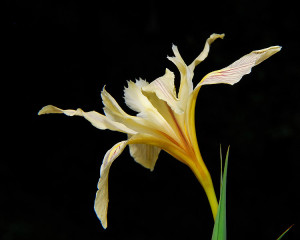
This species lacks the bowl-shaped enlargement on the corolla tube that is seen with Iris macrosiphon
Fernald’s iris crosses readily with other native irises that may be found nearby, including Iris douglasiana, Iris innominata, and Iris macrosiphon, which can further confound identification. Thus far this is the only iris we’ve observed on the property, and where it likes to grow, it appears to be quite prolific! The ability of Iris fernaldii to hybridize in the wild, occasionally results in some plants of this species being reported as having lavender flowers. We have only observed the yellowish-white form here on the property.
The flowers of Iris fernaldii appear between April and July, and are comprised of three standards, three falls, and three style arms, under which the stigma and anthers are found.
Iris fernaldii has flowers that are a cream to yellow color, but with a pronounced burgundy-purple veining, with darker yellow prominent veins and a yellow signal. Note that this is a beardless species of iris. Beardless iris usually have a signal (an area of bright contrasting color) that replaces the beard seen in bearded iris.
The petals (or standards) of Iris fernaldii are upright and slightly spreading, shorter and narrower than the sepals (falls), and similar in coloration. The flowering stalk is shorter than the surrounding leaves.
The leaves of this iris species are typically a dark gray-green. Some report that the base of the leaves are burgundy red in I. fernaldii, and white for I. macrosiphon, but much variability in coloration has also been observed (perhaps a result of hybridization between species at some point in time). The leaves emerge from fibrous branching rhizomes as dense, compact clumps.
The seeds produced by native iris are attractive to wildlife, and the flowers provide nectar to insects and hummingbirds.
Numerous Native American tribes, including the Pomo, Karok, and Tolowa are known to have made very fine cordage from wild iris leaves, which in turn was crafted into fishing nets, string, rope, and snares strong enough to catch deer. [1]
The Society for Pacific Coast Native Iris suggests that this particular species favors the unique soil and climate conditions of central California’s wine growing region. The soils that favor Fernald’s iris, apparently also favor good vineyard crops…which hopefully will be good news for us when we get around to planting a few grapes.
Iris fernaldii spreads via underground rhizomes, although its fibrous roots are difficult to dig, and from seed. It prefers a slightly acidic to neutral soil, will grow in part sun to shade, and tolerates drought quite well. Iris fernaldii is occasionally available through some specialty California native plant nurseries.
In cultivation this species needs good drainage, and reportedly benefits from some summer watering and a light mulch. Here the majority of plants have a southeast to southern exposure, with no supplemental irrigation, and seem quite drought tolerant in our soils. Although the leaves do scorch if exposed to prolonged full sun. We’ll be curious to see if the iris along the edge of the orchard perform better with exposure to occasional supplemental irrigation in the years to come.
[1] Daniel E. Moerman’s Native American Ethnobotanical Database




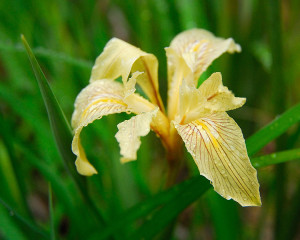


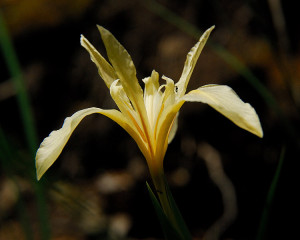
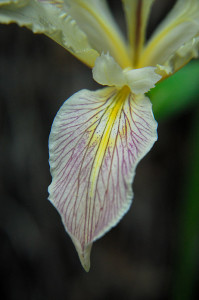
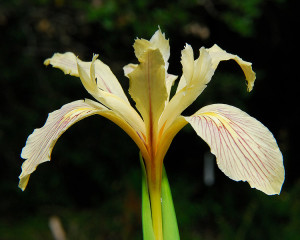

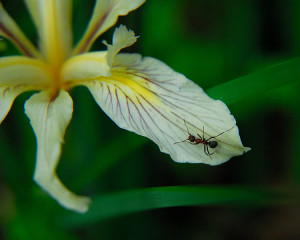









What a beauty…don’t you love the different names of the iris…Falls, standards, beards. gail
.-= gail´s last blog ..The Day Is Long =-.
I don’t think I’ve ever met an iris I didn’t like, but this is a particularly lovely species (and one that I’d never heard of before). Thanks for educating me about it. -Jean
.-= Jean´s last blog ..Spring Clean-Up =-.
Beautiful photos – so great that those are wild irises. I’ve got some foliage up in my garden – so excited for iris season here in Philly!
.-= Kelly@LifOutOfDoors´s last blog ..Pathetic Pink Dogwoods Anyone? =-.
Absolutely gorgeous iris. And kudos for identifying it!
.-= Dog Island Farm´s last blog ..The Ornamental Garden =-.
I didn’t realize there were more than just the Douglas iris, among natives. Thanks for sharing, and all for your thorough scholarship.
.-= Lisa´s last blog ..Honeybee Swarm! =-.
Dear Clare, What a wonderful Iris, so beautifully marked and so elegant in habit. And, to have it growing wild on your estate, that is riches indeed.
I have no knowledge of this species and shall certainly be looking it up. I do so love Irises.
.-= Edith Hope´s last blog ..White Linen, Magnolia and a Gherkin =-.
oh wow, great shots, such beautiful markings will have to research this one further, thanks for sharing
.-= Ena Ronayne´s last blog ..Impressive Imagery =-.
How delicate and lovely … you capture so many moods! beautiful light and imagine making nets from this plant! Sturdy enough to catch a deer! Wow! Native Americans are so clever… they had such an awareness and vast knowledge of their world. Thank you for this very interesting post!
.-= Carol´s last blog ..Buds and Birds A Silent Slow Walk About =-.
I have never seen an iris which I didn’t like. This one is very elegant, and you took great shots!
.-= Tatyana´s last blog ..Special April. Remembrance =-.
Very pretty, love the coloring! I just read that there is a native iris here, I’m going to be looking for it.
.-= Catherine´s last blog ..April 2010 Garden Blogger’s Bloom Day. =-.
What a beauty…I noticed that it is not cut but still in the garden. Exactly where it belongs for all of us with a cutting phobia, lol! Kim
.-= the inadvertent farmer´s last blog ..A Vase of Sunshine and the need for Therapy =-.
What an interesting and unusual iris (in my experience, which is pretty limited to begin with!). It almost looks a little like an orchid in some of your photos. How nice to have them scattered all about! Happy spring;-)
.-= Jan (Thanks For Today)´s last blog ..April 15th Bloom Day and Earth Day Project Deadline =-.
Thank you so much for publishing this extensive description and supporting information regarding this plant. I especially appreciated your including Native American uses and the names of the groups who used it.
.-= graceonline´s last blog ..We use (almost) enough bottled water to fill the Rose Bowl every day =-.
It’s a stunning bloom … and your photos really show off its beauty. I so enjoyed finding out about this wild beauty.
How nice that you have a visual environmental indicator that you most likely have good vineyard conditions. These irises are so elegant looking.
As a huge iris lover (so many, so wonderful, and each unique), I was intrigued by your informative post. The Native American input, part of my heritage, struck my fancy 🙂 Stunning photos and a pure joy to read.
.-= joey´s last blog ..‘AND SPRING AROSE ON THE GARDEN FAIR’ ~ MEDITERRANEAN TORTA / CHOPPED GREEK SALAD =-.
What a beautiful plant, made more beautiful by the fact that it is a native. Your photos are great.!
.-= debsgarden´s last blog ..My Secrets to a Low Maintenance Garden =-.
A beautiful iris. I’ve never seen it before and wonder why it isn’t planted more in gardens. Thanks for the honest scrap award (more on my comment on that post). As always love all the details and admire your plant id’ing skills.
.-= Brad´s last blog ..April Garden Bloggers’ Bloom Day – Tax edition =-.
Clare, so delicate in its beauty are these iris. Naturalized on our hillside and throughout the PNW are Iris tenax, a lovely light purple specimen; they brighten the dark field outside our deer fence but they stubbornly self-seed in some of my flower beds and we go at it occasionally one on one. 😉
I’m headed to the potting shed to repot my vegetables that are out growing their pot size… still a little leery in putting some of them out just yet.
I hope you have wonderful and enjoyable weekend. Diana
P.S. my husband, my best friend too. 😉
.-= Diana´s last blog ..Earth Day, A Way Of Life =-.
This is a subtle gorgeous plant. Much nicer than some of the bigger cultivated ones.
.-= melanie´s last blog ..Derek Jarmen’s Garden Philosophy =-.
Wow! I guess the woodland flowers are typically white to get attention from pollinators in the dark under the canopy? I love how plants adapt to conditions. That iris is a true stunner.
.-= Christine´s last blog ..Presenting: Mariposa Lily in Four Acts =-.
My goal is to now introduce some type of Iris into my garden this year. Yes, alas I don’t have any now…but you’ve inspired me with your lovely photographs. thank you! UDG
.-= Urban Dirt Girl´s last blog ..call the police!! =-.